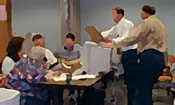

Chapter 16 - Skill-Building:
Learning Focus, Research, Invention, Inclusion and Strategy
Learn by doing.The most promising and time efficient method to introduce the school council to the skills outlined in the previous four chapters is to have them read about them and then practice them in a simulated change experience such as the "Change Game."1 This kind of learning may require a full day's workshop to complete thoroughly and effectively.
The "Change Game" is meant to acquaint players with the stages and the strategies involved in the introduction and implementation of a new program within a school district. While it is aimed at changing an entire district's behavior regarding gender issues, the game is an excellent introduction to classic change theories, specifically CBAM.
Having read the preceding chapters prior to playing this game, the school council members will probably emerge from the first round of play questioning the efficacy of some of the game's rules and strategies. This is exactly the desired outcome. The purpose of playing this game is to involve the team in critiquing the model of change incorporated in the game.
Which strategies for change are ignored? Which ones are missing?
Which strategies are given too much credit for effectiveness?
In what ways does this game illustrate the "implantation" approach to school innovation?
How might you change the game to make it a more appropriate model of effective change, to address the issues of Focus, Research, Invention, Inclusion and Strategy introduced in earlier chapters of this book? What rules would you change? What options would you add? How would you adapt this game so that it might be used to address site-based management and building level change?
The school council might take the basic game structure and design a variation which would address teaching for reasoning or cooperative learning within a single building. Building such a game requires systems thinking -- how do the various elements interrelate and what are the rules governing outcomes? Translation of theory into practice, even simulated experience, equips the team with the perspective to apply the theory to the real school program in the near future.
We are all creatures of habit to some extent. Reliance upon patterns and procedures makes a great deal of sense much of the time. Routines allow us to function without wasting effort on deciding each move afresh. We need to move somewhat automatically from task to task saving our best thinking for those tasks which deserve more imaginative attention. Unfortunately, much of this automatic behavior may become so deeply ingrained that it is unexamined behavior no longer appropriate for changing circumstances.
We are not all that different from animals in our need for certain reassuring patterns. Much like the deer who follow certain consistent paths to the water hole, we set up routines and paths which get us to work on time or help us to deliver a fairly good lesson even when our students arrive in class frazzled from a difficult weekend. We identify good scripts which tell us how to behave in certain circumstances and we store them like cassettes or CDs so they are ready to drop into place when we need them.
When people move into deer terrain with their roads and houses, the deer cannot seem to give up their old patterns. They continue to cross the hill where they have always crossed, even though that behavior now means a 2-3 per cent chance of death during the year. They continue to skirt the field where a new house and swimming pool now stand, even though they end up confronted by a huge wire fence that forces them to go way out of their path further down.
Unlike humans, deer seem incapable of seeing the big picture and altering their paths to fit new circumstances. This resistance to change and ignorance of systems thinking often leads to their death.
Sometimes people in schools do wait too long before altering their scripts and their behaviors to fit changing circumstances. These are the schools where planning is done with the head firmly entrenched in the sand or cement or mud.
Playing the change game and then re-inventing the game prepares a school council to see the big picture and start inventing new scripts to fit a rapidly changing world. It is a reasonably enjoyable way to learn systems theory and thereby avoid crossing the road while cars and trucks may be speeding by. An awareness of change theory reduces the likelihood that they will be frozen in the headlights of an oncoming vehicle.
Later on in the change process it is important to give the rest of the school community an opportunity to play this change game and to examine their attitudes toward change. It is not enough for the school council to see the big picture. Inclusion requires involvement of peers and colleagues in playing and re-inventing the change game so they may also learn to stay out of the way of crossing traffic. They will come to see change as inevitable and to accept adaptation as a comfortable and effective response which is preferable to denial or intransigence. If one has no choice about the existence of change, one can at least chose how to experience change.
Copyrighted 1991 by Jamie McKenzie, all rights reserved.